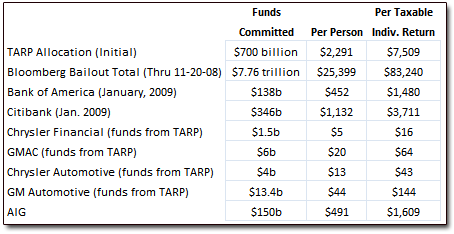People hear terms like "billions of dollars" and the now oh-so-in-vogue "trillions of dollars" and their minds seize up.
My thesis? We Americans are numb to the -illions these days. So in this post, I'd like to do my part to stick a crusty needle in the eye of all those folks who think American Idol goings-on are more important than the latest bailout news crossing Bloomberg.
Here goes:

The second column ("Per Person") is the amount of each bailout event as divided by the estimated U.S. population in January, 2009. In other words, this is the amount of bailout funds committed if it were to be paid by every man, woman, and child in the country. (Taxes don't work this way, obviously, but it makes for an easy benchmark.)
Column three ("Per Taxable Indiv. Return") is a little more complex. The IRS estimates it will receive over 138.3 million individual tax returns in 2008. They also note on their site that as of 2005, roughly 67.4 percent of tax returns owed an amount of tax greater than zero. By taking this percentage of estimated 2008 individual returns, I get a rough idea of how many individual 2008 tax returns will owe at least some amount of tax. The number in the chart, then, might best be described as the "amount committed per tax return of people who make enough to actually pay Uncle Sam."
Note 1: Individuals aren't the only taxpayers. Corporations pay taxes too, as do estates and trusts and a host of other entities. So the amounts calculated above are not meant to be final; they just make for a simplified breakdown mechanism. We're talking billion- and trillion-dollar expenditures here, people!
Note 2: The chart is not cumulative. Some of the "bailout events" noted in the chart (GM's and Chrysler's lifelines, for example) are contained in other listed bailouts (like TARP, in the GM / Chrysler case). I laid out the items this way because I wanted to get a better per-entity breakdown of the spending. (Gubmint sho' was chintzy with the carmakers, huh?)
In truth, we'll not know the true cost to taxpayers until many years in the future ... if ever. (My guess is never, but I'm cynical like that.) Most of these bailouts are best termed "very high-risk loans to insolvent institutions." And I'm quite certain that we've not seen the last bailout checks be written.
Sources:
Ritholtz.com: Big Bailouts, Bigger Bucks
Bloomberg: Follow the $7.4 Trillion
Bloomberg: U.S. Pledges Top $7.7 Trillion
Bloomberg: Lewis' Merrill, Countrywide Buys May Hurt Him
Detroit Free Press: Chrysler Financial Gets Federal Loan
IRS: Estimated Returns Filed, By State (XL spreadsheet)
Census.gov: Census Projects U.S. Population of 305.5 Million...
Labels: Bailouts, Statistics


